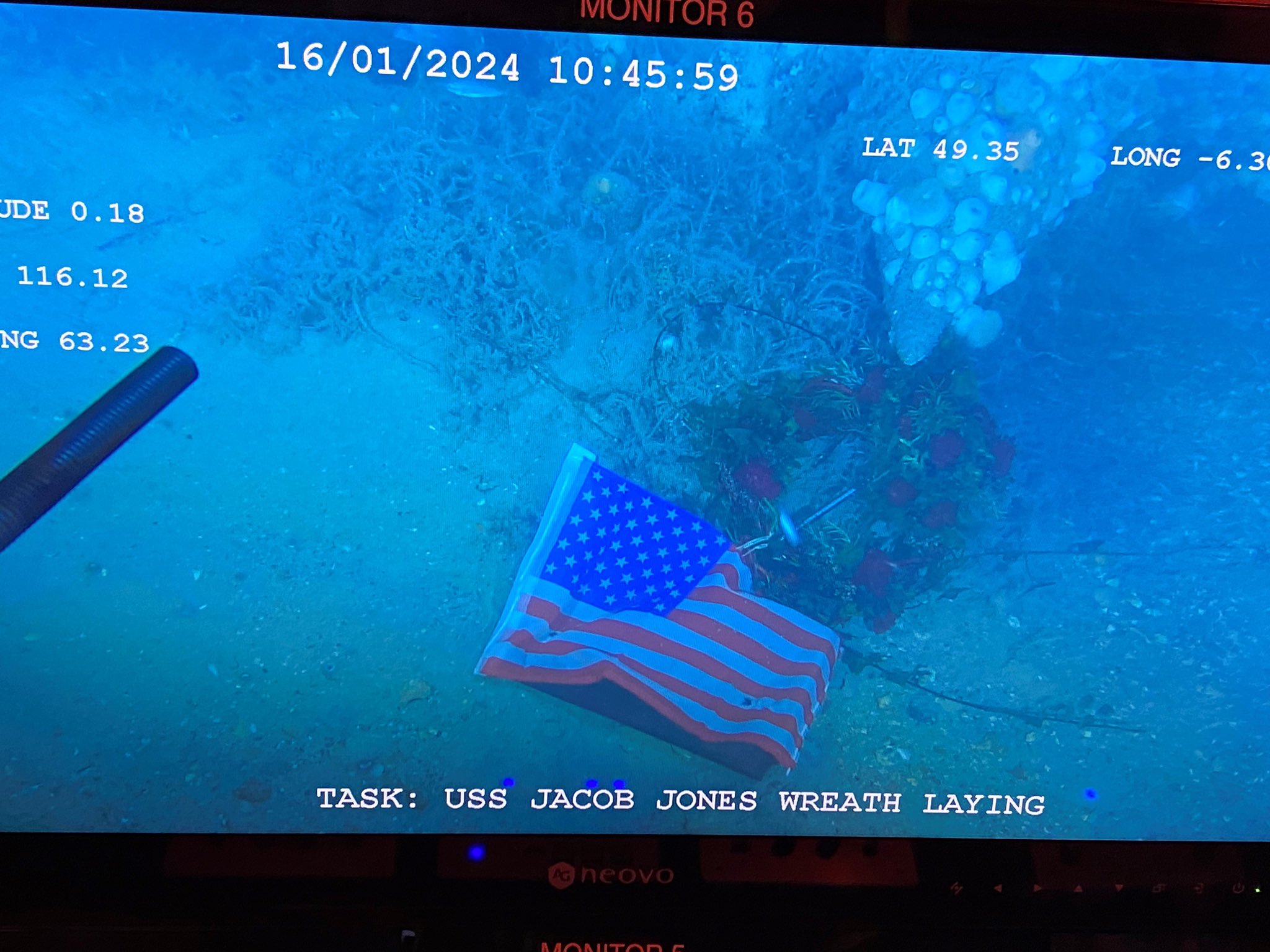The UK Ministry of Defence’s Salvage and Marine Operations (SALMO) unit has successfully retrieved an essential artifact from the wreckage of the USS Jacob Jones (DD-61), a World War I destroyer lost to enemy action.
The survey operation, which resulted in the artifact’s recovery, was initiated following a request from the Naval History and Heritage Command (NHHC) and received crucial support from the US Embassy in London.
The USS Jacob Jones holds a solemn place in naval history as the first US Navy Destroyer to be lost to enemy action during World War One. Sunk by the German submarine U-53 on December 6, 1917, the ship’s demise tragically claimed the lives of 64 sailors.
Despite the valiant efforts of those involved, including a posthumously awarded Navy Distinguished Service Medal for the deck officer directing rescue operations, the ship sank within eight minutes of being struck.
In August 2022, technical divers discovered the wreck of the USS Jacob Jones near the Isles of Scilly, England. Subsequently, efforts have been initiated to preserve and investigate the site, acknowledging its importance as a historical relic and a respectful resting site for the deceased.

The recent survey by SALMO utilizing remotely operated vehicles (ROVs) marks a pivotal moment in this ongoing endeavor. Not only did the team successfully recover the ship’s bell, but they also paid tribute to the fallen sailors by placing a wreath and American flag on the wreck.
Rear Admiral Sam J. Cox, Director of NHHC, said, “The ship played an important role safeguarding convoys carrying the troops and supplies from the United States to the United Kingdom and France that were critical to Allied victory.”
Cox explained, “The wreck of the ship is a hallowed war grave and is the last resting place for many of the 64 men who were lost in the sinking. US Navy policy is to leave such wrecks undisturbed. However, due to the risk of unauthorized and illegal salvaging of the ship’s bell, NHHC requested the Ministry of Defence’s assistance.”
“The US Navy is grateful to the SALMO team for recovering the bell, which will serve as a memorial to sailors who made the ultimate sacrifice in the defense of both the United States and the United Kingdom,” he added.

The bell, now in the temporary custody of Wessex Archaeology, will undergo conservation treatment before being transferred to NHHC’s Underwater Archaeology Branch for eventual display at the National Museum of the US Navy.
According to the official statement, this ceremonial handover, scheduled for later this year, will serve as a poignant reminder of the sacrifices made by sailors to defend their nations.
USS Jacob Jones (DD-61)
Jacob Jones (DD-61) is significant in US naval history as the first US destroyer lost to enemy action during World War I.
Launched on May 29, 1915, with sponsorship from Mrs. Jerome Parker Crittendom, the great-granddaughter of Commodore Jacob Jones, the ship was commissioned on February 10, 1916, under the command of Lieutenant Commander W. S. Pye.
When the United States entered World War I in April 1917, Jacob Jones patrolled off the Virginia coast. Soon after, on May 7, she departed Boston for Europe, armed with 4 x 4” (102 mm)/50-caliber guns and 8 x 21” (533 mm) torpedo tubes.
Powered by two Curtis steam turbines delivering 17,000 shaft horsepower to two screw turbines, supplemented by a third turbine for cruising, the vessel boasted a top speed of 30.32 knots (56.15 km/h). Its crew comprised five Wardroom Officers, nine Chief Petty Officers, and 87 enlisted men.
Ten days after arriving at Queenstown, Ireland, Jacob Jones commenced patrols and convoy escort duties in the waters of the United Kingdom.

The Jacob Jones conducted several daring rescue operations in 1917 while escorting convoys through dangerous submarine-infested waters. On July 8, she rescued 44 survivors from the British steamship Valetta, which had fallen victim to a U-boat attack.
Later the same month, Jacob Jones spotted a periscope while escorting the British steamship Dafila, but the steamship was torpedoed before the destroyer could retaliate.
Nonetheless, Jacob Jones managed to save 25 survivors from the sinking Dafila. In another remarkable rescue, she picked up 305 survivors from the torpedoed British cruiser Orama while on special escort duty between Ireland and France.
However, tragedy struck on December 6, 1917, as Jacob Jones was en route from Brest, France, to Queenstown, Ireland. While steaming independently southeast of Bishop Rock, Scilly Islands, the destroyer fell victim to a torpedo strike from a German U-boat.

Despite valiant efforts to evade the attack, the vessel succumbed to the assault, sinking within eight minutes with a devastating loss of life—2 officers and 62 men.
For over a century, the whereabouts of Jacob Jones remained a mystery until a team of technical divers based in the United Kingdom, known as Darkstar, recently located its final resting place in 2022.
Meanwhile, a second destroyer bearing the name Jacob Jones (DD-130) was laid down at the New York Shipbuilding Corporation in Camden, New Jersey, on February 21, 1918, and launched on November 20, 1918, sponsored by Mrs. Cazenove Doughton, another great-granddaughter of Commodore Jacob Jones.
Sadly, this vessel met a similar fate, being sunk by a U-boat on February 28, 1942, during World War II.
- Contact the author at ashishmichel(at)gmail.com
- Follow EurAsian Times on Google News




